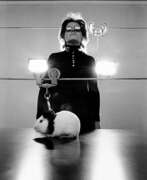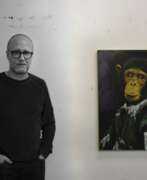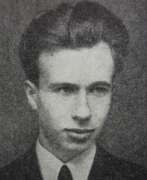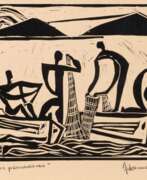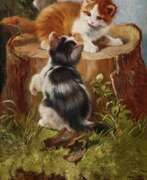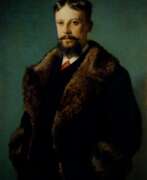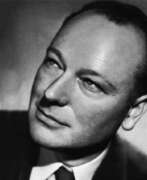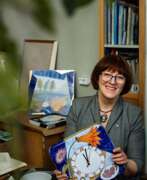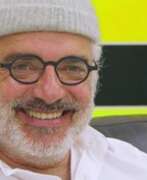20th century


Antonio De Simone was an Italian marine painter.
He created many paintings depicting various ships at sea: frigates, yachts, sailing ships and steamships, in the storm and with the sails down. De Simone also painted historical battle scenes, such as his famous painting - "Bombardment of Alexandria", which is in the Royal Greenwich Museums.


Jenny Fikentscher (born Nottebohm) was a German painter and graphic artist associated with the Art Nouveau movement. She studied at the School of Women Painters in Karlsruhe and later became part of the Grötzingen artist colony. Fikentscher married animal painter Otto Fikentscher and raised five children in an unconventional artistic household. She was known for her botanical motifs and lithographs, often featuring local plants. Fikentscher also created collectible images for the Stollwerck chocolate company.


Alexander Grigorievich Maksymenko (Russian: Александр Григорьевич Максименко) was a Soviet and Ukrainian painter of the second half of the twentieth and early twenty-first centuries. He is known as a painter, graphic artist, watercolorist, and art historian.
Alexander Maksymenko worked in the genres of still life, landscape, portrait, as well as in genre painting. His genre works cover themes of collective farm life, including "Masters of the Land" and "Innovators of Collective Farm Fields". For the latter work he received the Stalin Prize. The master actively participated in exhibitions in Ukraine and abroad. His works are in the National Art Museum of Ukraine, the Museum of the History of Ukraine in World War II, as well as in other art museums and private collections.


Herbert Ritts Jr. was an American fashion photographer and director known for his photographs of celebrities, models, and other cultural figures throughout the 1980s and 1990s. His work concentrated on black and white photography and portraits, often in the style of classical Greek sculpture, which emphasized the human shape.


Wilhelm Schmurr was a German painter and co-founder of the Sonderbund in Düsseldorf. His style, characterized by clear expression, was influenced by the Pre-Raphaelites, Symbolists, and Realists. He received several awards and medals for his work and was a member of various art associations. Schmurr taught at the Kunstakademie Düsseldorf and inspired by the farmers after the war, he created scenes of simple life and still lifes. He was awarded the Karl-Ernst-Osthaus-Preis and the Bundesverdienstkreuz erster Klasse and became an honorary member of various artist associations.


Jan Leth Aagensen was a Danish artist. He made his name as a lithographer and later became known for his sculptures.
Jan Leth's formal training took place at the Royal Danish Academy of Fine Arts under Professor Søren Hjort Nielsen from 1965 to 1969. His first exhibition took place in 1961 at Kunstnernes Forårudstilling (Spring Artists' Exhibition). He is a member of various art groups: Decembristerne, Kunstnersamfundet og Foreningen Danske Grafikere, the Association of the Royal Danish Academy of Fine Arts and the Association of Danish Painters Engravers.
Jan Leth has participated in various solo and group exhibitions, presenting paintings, sculptures, drawings, and installations in Denmark and abroad. He has received many honours and grants throughout his life. The Danish State gave him a lifelong economic grant in 1998. His work is represented in gallery collections in Denmark and internationally.


Wäinö Waldemar Aaltonen was a Finnish artist and sculptor, celebrated for his contributions to the cultural landscape of Finland, particularly during the early years of the nation's independence. Born in 1894, Aaltonen's works are distinguished by their nationalist themes and monumental scale, often reflecting the spirit and identity of Finland. His artistic journey was notably influenced by a trip to Italy in 1923, where he encountered cubist and futurist art, elements of which he integrated into his own work.
Aaltonen's sculptures are key features in Finland's public spaces, including the well-known statues in the House of Parliament and numerous works in Turku, such as the "Lily of Turku" and a statue of the runner Paavo Nurmi. His mastery is also showcased at the Wäinö Aaltonen Museum of Art in Turku, which houses a significant collection of his sculptures, paintings, and drawings. This museum not only celebrates his legacy but also serves as a central repository for his extensive works, donated by Aaltonen himself.
For those interested in exploring Aaltonen's work and the impact of Finnish sculpture, a visit to the Wäinö Aaltonen Museum of Art is invaluable. The museum provides a comprehensive view of his artistic evolution and contributions to Finnish art. For updates on exhibitions and events related to Wäinö Aaltonen, consider signing up for notifications through the museum's mailing list, ensuring you stay informed about new insights and offerings related to this pivotal artist.


Johan Victor Aarne, born Lindström in Sweden, was a Finnish jeweller who collaborated with the Fabergé firm and was a supplier to the Imperial Court.
Aarne was educated in the art of jewellery by the renowned jeweller Johan Erik Hellsten. He worked in the workshop of August Holmström, included in the Fabergé firm, before opening his own workshop. In 1891 he moved to St. Petersburg, where he worked directly for Fabergé. In 1904, he sold the workshop and moved to Vyborg, continuing to work successfully in the jewellery business.


Pavel Efimovich Ab (Russian: Павел Ефимович Аб) was a Russian Soviet artist, born on November 22, 1902, in Orel. He is renowned for his contributions to painting and graphic arts, having studied under notable mentors such as Kuzma Petrov-Vodkin and A. I. Savinov at the VKhUTEIN in Leningrad during the years 1923 to 1929.
Ab's career was deeply influenced by his experiences during the Great Patriotic War, where he served in the 21st Rifle Division of the NKVD on the Leningrad Front. His war-time sketches of city defenders and subsequent military honors played a significant role in his artistic expression. After the war, he continued to actively participate in the creative community, producing notable works like "Pavlov in Koltushi" and "Speech of V. I. Lenin at the Admiralty Shipyards".
His artworks, which often depicted military and historical themes, are preserved in various museums and private collections in Russia and abroad. Ab's commitment to the Leningrad Union of Artists until his death in 1974 ensured that his legacy would influence future generations of artists.
For enthusiasts and collectors keen on exploring Russian Soviet art, staying updated on exhibitions and sales featuring Pavel Efimovich Ab's works can be enriching. Sign up here for updates related to new product sales and auction events concerning Ab's art.


Vilmos Aba-Novák was a distinguished Hungarian artist, celebrated for his unique blend of Expressionism with classical and Renaissance influences. Born in Budapest in 1894, he was deeply influenced by his experiences in the Austro-Hungarian Army during World War I, which later permeated his art. Aba-Novák is best known for his vibrant frescoes and murals that decorate several public buildings in Hungary, including churches and civic buildings in Szeged and Budapest.
His works, characterized by dynamic compositions and a bold use of color, often depicted village fairs, circuses, and everyday Hungarian life, bringing an almost fantastical quality to these scenes. His remarkable ability to combine traditional subjects with modern artistic elements made his work a significant contribution to modern Hungarian art. Aba-Novák's art was not only appreciated in his homeland but also internationally, earning him major awards like the Grand Prize at the Paris World Exhibition in 1937 and at the 1940 Venice Biennale.
For art collectors and enthusiasts interested in exploring or purchasing Vilmos Aba-Novák's works, staying informed about upcoming sales and exhibitions is crucial. Signing up for updates can provide valuable insights into available pieces and auction events. To keep abreast of such opportunities, consider registering for newsletters or alerts specifically tailored to Aba-Novák's art. This will ensure you don't miss out on acquiring a piece of this unique artistic heritage.


Pacita Abad was a renowned Filipino artist, celebrated for her vibrant and colorful artwork that showcased her deep engagement with global cultures and social issues. Born in 1946 in Batanes, Philippines, into a politically active family, Abad's life took a significant turn when she decided to abandon her law studies in favor of art, influenced by her interactions and travels across the globe. This decision led her to explore various art forms and techniques, including trapunto painting—a method where canvases are stitched and padded to create a three-dimensional effect.
Abad's art was profoundly influenced by her extensive travels with her husband, Jack Garrity, through more than 60 countries, where she not only collected textiles but also immersed herself in local cultures. This exposure is vividly reflected in her works, which often incorporate traditional fabrics and objects, such as beads and shells, integrating them into her colorful abstract and figurative paintings.
Throughout her career, Abad's works were displayed in over 200 museums and galleries worldwide, including prestigious venues like Tate Modern and the Museum of Modern Art (MoMA) PS1. Her work not only celebrates the visual and cultural diversity she encountered but also addresses global and humanitarian issues, such as the plight of refugees, which she depicted through intimate and powerful portraits of women and children.
Pacita Abad's legacy continues to inspire and influence the art world, highlighting her role as an "ambassador of colors" whose works helped to "make the world smile" with their exuberance and vibrancy. If you're interested in learning more about her life and work, consider signing up for updates on exhibitions and sales related to her art. This will keep you informed about opportunities to engage with and perhaps collect pieces from the oeuvre of this groundbreaking artist.


Sultan Shamsutdinovich Abaev (Russian: Султан Шамсутдинович Абаев), a Chechen and Russian artist born on November 1, 1954, in Khaidarkan, Soviet Union, is celebrated for his distinctive contributions to landscape art. A member of the Artists Unions of Saint Petersburg and the Chechen Republic, Abaev's work exemplifies his profound connection to his cultural roots and the rich landscapes that inspire him.
Educated at the prestigious Repin Institute of Painting, Sculpture, and Architecture in Saint Petersburg, Abaev has been honored multiple times for his artistic achievements, including receiving the title of Honored Artist of the Russian Federation. His works have been internationally recognized, finding places in private collections across countries such as Germany, the United States, and Japan.
Abaev's career also includes time spent abroad in Sri Lanka and South Korea from 1991 to 1993, where he expanded his artistic horizons and produced a series of paintings influenced by these experiences. Today, his works are sought after by collectors, especially those interested in landscapes and cultural narratives embedded in art.
Stay updated on exhibitions and sales related to Sultan Shamsutdinovich Abaev's enchanting landscapes by signing up for our exclusive alerts. These updates are essential for collectors and art connoisseurs interested in owning a piece of Chechen and Russian art history.


Magdalena Abakanowicz was a distinguished Polish artist, celebrated for her innovative use of textiles as a sculptural medium. Born on June 20, 1930, in Falenty, Poland, and passing away on April 20, 2017, in Warsaw, she carved out a significant place in the art world with her unique artistic expressions that often explored themes of crowd behavior, the trauma of war, and the individuality of the human condition.
Abakanowicz's education at the Academy of Fine Arts in Warsaw was a period of both artistic and personal growth, shaping her future works. During the 1960s, she began creating the "Abakans," large-scale textile sculptures that challenged conventional forms and expressed dynamic movement and vivid emotion. Her works often featured organic, tactile materials like burlap, resin, and wood, which added a profound depth and rawness to her sculptures.
Her sculptures are well-represented in major public installations and collections worldwide, including the National Museum in Wrocław, Poland, Grant Park in Chicago, and the National Gallery of Art Sculpture Garden in Washington, D.C. These pieces are not just art forms but are experiences, inviting viewers to explore deeper psychological and existential themes.
For those captivated by the profound impact and the stirring beauty of Magdalena Abakanowicz's work, subscribing for updates can provide regular insights and information on exhibitions and sales of her works at auctions. This is an excellent way to stay connected with the legacy of an artist who continuously redefined the boundaries of sculpture and installation art.


Mikhail Georgievich Abakumov (Russian: Михаил Георгиевич Абакумов) was a Russian artist, celebrated for his diverse artistic contributions and his deep connection to his homeland, Kolomna. Born in 1948, Abakumov became a prominent figure in the Russian art scene, recognized as a People's Artist of Russia and a dedicated teacher and community leader in Kolomna.
Abakumov's artistic oeuvre includes industrial and genre canvases, evocative landscapes, and intimate portraits, which are held in high esteem across Russia and in private collections worldwide. Notable works like "Metallurg" (1974) and "Spring Morning" (1996) showcase his ability to capture the essence of Russian life and landscapes. His art has been exhibited extensively within Russia and internationally, including over thirty solo exhibitions since 1979, contributing significantly to the cultural tapestry of the Soviet and post-Soviet periods.
His works are part of prestigious collections, including the State Tretyakov Gallery, and have been featured in various museums across cities like Moscow, St. Petersburg, and internationally.
For those interested in exploring Russian art and the legacy of Mikhail Georgievich Abakumov, signing up for updates on exhibitions and sales of his artworks can provide valuable insights and opportunities. Join our community to stay informed about events and auctions featuring Abakumov's remarkable works.


Ivan Mikhailovich Abalyaev (Russian: Иван Михайлович Абаляев) was a Russian artist, recognized for his influential role in the Leningrad School of Painting. Born into a peasant family in 1924, Abalyaev's artistic journey began at the Leningrad Institute of Painting, Sculpture, and Architecture. His art, characterized by a profound connection to Russian rural life and landscapes, captures the essence of his early life experiences in Nizhnyaya Loshikha, Smolensk region.
Abalyaev's works are renowned for their vivid portrayal of the Russian countryside, often reflecting the serene and laborious life of its inhabitants. His mastery in landscape painting earned him significant recognition, including the prestigious title of People's Artist of the Russian Federation. Throughout his career, Abalyaev remained dedicated to exploring and expressing the natural beauty and the cultural depth of rural Russia, contributing significantly to the cultural heritage of his country.
For those interested in the evocative landscapes and cultural narratives captured by Ivan Mikhailovich Abalyaev, his works are valuable collectibles and are often featured in art galleries and auctions. To stay updated on new discoveries of his works and upcoming auction events featuring Abalyaev, signing up for updates is highly recommended. This will ensure that collectors and art enthusiasts don't miss out on the opportunity to own a piece of Russian art history.


Louise Abbéma was a French painter, sculptor, and designer, celebrated for her work during the Belle Époque. Born in Étampes in 1853 into an affluent Parisian family, she became well known for her portraits, particularly of the famous actress Sarah Bernhardt, and for decorative panels commissioned for various public buildings in Paris and the Palace of the Governor in Dakar, Senegal.
Abbéma's art often depicted the upper echelons of French society and reflected the Impressionist style through her light and rapid brushstrokes. She was also notable for her involvement in the women's movement, where she contributed to the emerging image of the 'New Woman' by portraying androgynous figures and themes of intellectualism and freedom.
Among her many honors, Abbéma was awarded the Palme Academiques in 1887, nominated as the Official Painter of the Third Republic, and in 1906, she became a Chevalier of the Legion of Honour. Her works, such as "Lunch in the Greenhouse" and "Portrait of Sarah Bernhardt," have seen a resurgence in popularity as the contribution of women to historical art gains more recognition.
For those interested in the evocative and historically rich artworks of Louise Abbéma, consider subscribing to our updates. We'll keep you informed about new sales, auctions, and exhibitions featuring Abbéma's work, ensuring you're always connected to the latest offerings in the art and antique collectors' sphere.






Berenice Alice Abbott was an American photographer best known for her portraits of between-the-wars 20th century cultural figures, New York City photographs of architecture and urban design of the 1930s, and science interpretation in the 1940s to 1960s.


Shafic Abboud, also known as Chafic Abboud, was a renowned Lebanese painter whose artistic journey led him from Beirut to the vibrant art scene of Paris in 1947. Embracing the modernist and abstract movements of the mid 20th century, Abboud honed his skills at the ateliers of prominent artists like Jean Metzinger and Fernand Léger. This exposure influenced his transition from figurative and landscape painting to his signature colorful personal abstractions. Despite his years in France, Abboud remained deeply connected to his oriental roots, drawing inspiration from oral storytelling and Byzantine icons.
Abboud´s creativity extended to ceramics, terracotta, carpets, and lithography. His exceptional talent garnered global recognition, with exhibitions in prestigious venues like Doha's Mathaf and Paris's Institut du Monde Arabe. In May 2012, Beirut Exhibition Center celebrated his artistic legacy in a comprehensive exhibition.




Margitta Abels is a German artist known for her abstract paintings and mixed media works.
Margitta Abels has received numerous awards and honors for her work.
Abels' work is characterized by its use of color and texture to create complex and layered compositions. She often works with a variety of materials including acrylic paint, charcoal, and collage elements, and her work often incorporates textural elements such as sand and fabric.


Alfred Aberdam was a Polish painter associated with the School of Paris, known for his participation in the artistic movements of the early 20th century. Born in Lviv, then part of the Austro-Hungarian Empire, Aberdam's journey in the arts began with his studies at the Munich Academy in 1911. His life and work were marked by significant historical events, including imprisonment during World War I and an active period in Poland's art scene before settling in Paris. Aberdam's contributions are remembered through his numerous exhibitions, including solo showcases in Paris, London, and Tel-Aviv, as well as posthumous retrospectives like the one in Geneva's Petit Palais in 1970.
Aberdam's works reflect the cultural dynamism of the School of Paris, capturing a confluence of influences that characterized the European art scene. Despite being somewhat lesser-known, his paintings have been traded at auction, reflecting a continued interest and recognition of his artistic legacy. His art remains an important part of the narrative of Jewish painters in Paris from 1905 to 1939, contributing to our understanding of the era's artistic diversity.
For collectors and experts in art and antiques, Aberdam's work embodies the intricate history and cultural exchanges of the early 20th century European art world. His paintings not only represent his individual talent but also tell the story of the times in which he lived, worked, and created. Understanding Aberdam's art is a journey through the cultural melting pot that was Paris during a pivotal period in modern art history.
For those interested in exploring the legacy and works of Alfred Aberdam further, or seeking to keep abreast of new product sales and auction events related to his work, subscribing for updates is invaluable. Stay informed on the latest developments and opportunities to appreciate or acquire pieces by this notable artist. Subscribe now to ensure you are alerted to new sales and auction events featuring the esteemed Alfred Aberdam.


Anna Adelaïde Abrahams was a Dutch still life painter. Beginning in 1882 Abrahams showed her work in Levende Meesters (Living Masters) exhibitions throughout the Netherlands. She exhibited in Europe in Paris, Berlin, Düsseldorf and Brussels. She exhibited her work at the Palace of Fine Arts at the 1893 World's Columbian Exposition in Chicago, Illinois. Abrahams was a member of the art association Ons Doel Is Schoonheid (Our Goal Is Beauty) and was on the board of the Pulchri Studio.


Marina Abramović is a Serbian conceptual and performance artist. Her work explores body art, endurance art, feminist art, the relationship between the performer and audience, the limits of the body, and the possibilities of the mind. Being active for over four decades, Abramović refers to herself as the "grandmother of performance art". She pioneered a new notion of identity by bringing in the participation of observers, focusing on "confronting pain, blood, and physical limits of the body". In 2007, she founded the Marina Abramović Institute (MAI), a non-profit foundation for performance art.


Ruth Davidson Abrams, a Jewish-American painter, left a lasting impact on the art world. As the art director at the Research Association of The New School and a lecturer at Parsons The New School for Design, she influenced aspiring artists.
Abrams gained recognition for her outer-space-themed paintings, notably "There Are Unknown Elements in the Universe as Old as Mankind" (1962). She actively engaged in art classes led by influential artists like Alexander Archipenko and William Zorach, known for their abstract approach. Despite being overlooked in a male-dominated era, Abrams' talent is now acknowledged. Her papers are preserved at the Yeshiva University Museum and the Smithsonian Archives of American Art. She collaborated with renowned artists such as William Zorach, Alexander Archipenko, and John D. Graham.


Victor Ashotovich Abramyan (Russian: Виктор Ашотович Абрамян) was a Soviet and Russian artist of the second half of the twentieth and early twenty-first centuries. He is known as a painter, a representative of the Leningrad school.
Victor Abramyan created portraits, landscapes, still lifes and genre paintings. He participated in exhibitions from the early 1970s in Leningrad. Among his famous works are "Blockade everyday life", "Still Life with a Centennial", "Leningrad. 1942. Women on Guard in the besieged city", "Young Guests" and others.
Abramyan's works are in museums and private collections in Russia and many other countries.


Memet Abselyamovich Abselyamov (Russian: Мемет Абселямович Абселямов) was a mid-20th century Soviet artist of Crimean Tatar origin. He is known as a landscape painter.
Memet Abselyamov became famous in 1935 with his genre painting "Kolkhoznitsy Udarnitsy", which was awarded the All-Russian prize and acquired by the Moscow Museum of Folk Art. During his life in Tajikistan, where he came after the deportation of the Crimean Tatars, the artist created mainly landscapes, including the paintings "Night in the Crimea", "Crimean Cypresses", "Gurzuf. Where A. Pushkin visited", "Sunny Day", "Spring in Tajikistan", "The Last Ray" and others.
He was a member of such creative associations as "Krymkhudozhnik", the Union of Artists of the USSR, the Union of Artists of the Tajik SSR.


Carla Accardi was an Italian abstractionist painter associated with the Arte Informel and Arte Povera movements and a founding member of the art groups Forma (1947) and Continuità (1961). She studied painting at the Academy of Fine Arts in Palermo and Florence.
Carla Accardi was known for her innovative use of materials and her exploration of geometric shapes and vivid colours. One of her notable contributions was the introduction of the "tela intrecciata" (interwoven canvas) technique, in which she used strips of coloured canvas to create textured and layered compositions.
Accardi's work often exhibited a sense of rhythm and movement, a dynamic arrangement of forms and lines. Her compositions are characterised by a sense of balance and harmony and often incorporate elements of repetition and symmetry.


Angelo Accardi is a contemporary Italian artist. He grew up surrounded by both modern and traditional art. Although he studied fine art at the Art Academy of Naples, he never completed his training. Angelo Accardi illustrates surreal visions of everyday life under realistic backdrops of urban and natural landscapes. There is never a single meaning, but a whole story behind each painting. Ironic, striking, and playful, Accardi’s unique perspective and avant-garde style is a result of his diverse inspirations.


Vito Acconci was an American artist, designer, and architect. He is best known for his pioneering work in the field of performance art and for his provocative installations that explore the relationship between the human body and space.
Acconci received a Bachelor of Arts degree from Holy Cross College in 1962. He later earned a Master of Fine Arts degree from the University of Iowa.
In the late 1960s and early 1970s, Acconci became known for his groundbreaking performance works, which often involved the artist subjecting his own body to various forms of physical and psychological stress.
In the 1980s and 1990s, Acconci shifted his focus to installation art, creating immersive environments that challenged viewers' perceptions of space and their own bodies. He also worked as a designer and architect, creating public sculptures and buildings around the world.
Acconci's work has been exhibited in major museums and galleries worldwide, including the Museum of Modern Art in New York and the Venice Biennale. He received numerous awards and honors for his contributions to contemporary art, including the Skowhegan Medal for Sculpture in 1995.
His legacy as an influential and provocative artist continues to be felt in the contemporary art world today.
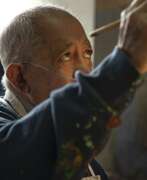

Gilberto Aceves Navarro was a Mexican painter and sculptor and a professor at the Escuela Nacional de Artes Plásticas and Academy of San Carlos. There have been more than two hundred individual exhibits of his work, with his murals found in Mexico, Japan and the United States. He received numerous awards for his work including grants as a Creador Artístico of the Sistema Nacional de Creadores de Arte, Premio Nacional de Ciencias y Artes and Bellas Artes Medal from the Instituto Nacional de Bellas Artes.




Andreas Achenbach was a German landscape and seascape painter in the Romantic style. He is considered to be one of the founders of the Düsseldorf School.[citation needed] His brother, Oswald, was also a well known landscape painter. Together, based on their initials, they were known as the "Alpha and Omega" of landscape painters.


Oswald Achenbach was a German painter associated with the Düsseldorf school of painting. Though little known today, during his lifetime he was counted among the most important landscape painters of Europe. Through his teaching activities, he influenced the Kunstakademie Düsseldorf. His brother, Andreas Achenbach, who was twelve years older, was also among the most important German landscape painters of the 19th century. The two brothers were humorously called "the A and O of Landscapes" (a reference to their initials matching a common German reference to the Alpha and Omega).


Peter Ackermann was a German painter and graphic artist. He became known for his alienation of architectural subjects. Ackermann was a representative of fantastic realism. The preferred subject of his work was classical Italian architecture, which he drew on site. He put together columns, portals and walls with machine parts, ruins and desolate parts of the city, which were piled up threateningly and thus alienated. In his etchings he showed references to the techniques of the old masters, his pictorial conception is compared with that of Giovanni Battista Piranesi and Canaletto.


Franz Ackermann is a German media artist.
He studied at the Academy of Fine Arts in Munich and at the University of Fine Arts in Hamburg, lives and works in Berlin and Karlsruhe.
Franz Ackermann's work includes drawings, watercolors, murals, paintings and installations, which he complements with photographic works, projections and architectural models. His works deal with the themes of tourism, globalization and urbanism and reflect the social changes and political problems caused by increasing globalization.


Otto Ackermann was a 19th-century German painter, mainly of landscapes. In 1897, he moved to Düsseldorf, where he remained until his death. He painted mainly landscape paintings of Belgium and the Netherlands, also working in printmaking on the same subjects. He was chairman of the local Düsseldorf Painters' Society and is mentioned in the diaries of Albert Herzfeld.


Julius Anton Adam was a German genre painter and animalist who specialised in the depiction of cats and was a member of an influential family of Munich painters.
Julius Anton Adam was a pupil of Professor Michael Echter and later Wilhelm von Dietz at the Munich Academy of Art. He later became a professor himself.


Henri-Georges Adam was a French engraver and non-figurative sculptor of the École de Paris, who was also involved in the creation of numerous monumental tapestries. His work in these three areas is regarded as among the most extensive of the twentieth century.


Heinrich Emil Adametz was a German expressionist painter.
Adametz studied in Hamburg and at the Academy of Fine Arts in Stuttgart. Influenced by Expressionism, he painted portraits, seascapes with ships, and still lifes. Later, the events of World War II took such a heavy toll on the artist's family that he was unable to recover from them for the rest of his life.


Arthur Adamov, born Arthur Adamian, is a French novelist and playwright, translator of Armenian origin.
Adamov was close to the Surrealists and was friends with Artaud and Giacometti. He wrote poetry and published the surrealist magazine "The Gap". In 1938 he had a nervous breakdown. In 1941 he was arrested for his hostile statements against the Vichy government, and was held in a camp in Argeles until the end of the war.
After the war, in a state of extreme depression, he began to write confessional prose and turned to drama.
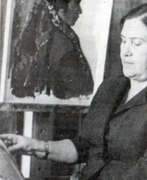

Yevgeniya Mikhailovna Adamova (Russian: Евгения Михайловна Адамова) was a Soviet artist of the second half of the twentieth century. She is known as a painter, People's Artist of the Turkmen SSR.
Yevgeniya Adamova, who moved to Turkmenistan from Ukraine in her youth, was educated at the Ashgabat Art School. During the Great Patriotic War, she creatively expressed herself as a poster artist in the TurkmenTAG agency. The artist created thematic paintings dedicated to the life of the Turkmen people and portraits. She held the post of deputy chairman of the Union of Artists of Turkmenistan.
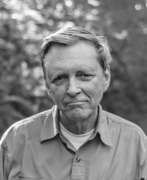

Robert Adams is an acclaimed American photographer known for his profound exploration of the American West's changing landscapes. His work, which gained prominence in the mid-1970s, delves into the tension between the natural beauty of the land and the marks of human encroachment. Adams's photography is a reflection on humanity's relationship with the environment, offering both a critique and a celebration of the landscape.
Robert Adams's notable series, such as "Turning Back" and "The New West," showcase his unique perspective on environmental and urban development issues. His work extends beyond just capturing images; it is a thoughtful commentary on the balance between nature and industrialization. His photographs, often devoid of people, focus on the land itself, telling a story of alteration and resilience.
Exhibitions of Adams's work, such as "American Silence: The Photographs of Robert Adams" at the National Gallery of Art, provide insight into his 50-year career and his ability to capture the silent yet profound narratives of the American landscape. His pieces are part of major collections and have been featured in numerous retrospectives, underlining his influence and significance in the world of photography.
For art collectors and enthusiasts, Robert Adams's work offers a poignant perspective on the American West, blending aesthetic beauty with critical environmental commentary. Engaging with his work invites reflection on our interaction with the landscape and our role in shaping the environment.
If you're interested in staying updated on Robert Adams's work and exhibitions, consider subscribing to newsletters from galleries and museums that feature his art. This way, you'll be informed about new displays of his work and opportunities to engage with his insightful perspectives on the American West.


Richard Adams is a British artist and illustrator living and working in Sussex.
Adams received an honors degree in graphic design from Leicester Polytechnic and initially worked as an illustrator in London. Richard Adams creates all his paintings using chalk pastels, then fixes and impregnates with a special varnish that leaves an impenetrable surface. He depicts a variety of English landscapes and seashores, often inhabited by quirky characters and animals, as well as amusing domestic scenes. The artist successfully captures the humor and absurdity of everyday life in a bygone and contemporary English style.
Adams' work is regularly exhibited in London and other UK cities to great acclaim, and internationally in Sydney, Washington DC, Bremen and Madrid.


Ansel Easton Adams was an American photographer and environmentalist, celebrated for his black-and-white images of the American West, particularly Yosemite National Park. His profound connection with nature was not only the subject of his art but also the essence of his environmental advocacy, earning him a revered place in both the art and conservation worlds.
Ansel Adams' early exposure to the beauty of nature and a supportive family environment nurtured his dual interests in music and photography. His photographic journey began with a simple Kodak Box Brownie camera, which he used during his early visits to Yosemite, a place that would become the central theme of his life's work. Ansel Adams' dedication to photography and the environment was interwoven, as he utilized his art to advocate for the conservation of America's natural landscapes.
In the 1930s, Adams co-founded Group f/64, advocating for photographic purity and sharpness of focus, principles that would define his work. His role in establishing the photography department at the Museum of Modern Art in New York underscored his commitment to elevating photography as a respected art form. Ansel Adams' work has been exhibited in prestigious institutions such as the Smithsonian American Art Museum and MoMA, showcasing his contributions to American art and environmentalism.
For collectors and art experts, Ansel Adams' legacy transcends his iconic images; it lies in his ability to merge aesthetic excellence with a passionate message of environmental stewardship. His photographs not only capture the grandeur of landscapes but also serve as a timeless call to preserve the natural world.
To delve deeper into the world of Ansel Easton Adams and stay updated on new product sales and auction events related to his work, signing up for updates is a step toward embracing the heritage of a pivotal figure in art and environmental advocacy.
Join our community of art and antique enthusiasts to honor Adams' vision and ensure his message continues to inspire future generations.


Hans Peter Adamski is a German painter and graphic artist who lives and works in Berlin and Dresden.
He studied at the Dusseldorf Academy of Art and served as professor and dean of the Dresden University of Fine Arts. Adamski is one of the most important representatives of the Neue Wilden ("New Wilden") movement of the 1980s. In addition to painting, he works in drawing, sculpture, paper, fabric and plaster.


Terry Roger Adkins was an American artist. He was Professor of Fine Arts in the School of Design at the University of Pennsylvania.
Adkins was an interdisciplinary artist whose practice included sculpture, performance, video, and photography. His artworks were often inspired by, dedicated to, or referred to musicians or musical instruments; specific installations and exhibitions were sometimes labeled "recitals." Sometimes, these arrangements of sculptures were "activated" in performances by Adkins' collaborative performance group, the Lone Wolf Recital Corps.


Marc Adrian is an Austrian conceptual artist and filmmaker.
Adrian studied sculpture at the Vienna Academy of Fine Arts, from 1953 he became interested in cinema, kinetics, rhythmic interference, problems of optical structures, etc. Adrian is considered one of the pioneers of film-oriented media art. He specialized in kinetic objects, anti-cinema and computer art.
Marc Adrian has taught at various universities in Europe and lectured to American students.


Lucien Adrion was a French post-impressionist painter, draughtsman and printmaker. He is known for his depictions of the French countryside and beaches, as well as of Parisian life, including landscapes, still lifes, figures and landmarks.
Throughout his career, Adrion exhibited his work at the Salons in Paris, where he was praised for his ability to capture the movement and transience of city life.


Jack W. Aeby is an American environmental physicist and photographer.
Aeby attended the University of Nebraska and was one of the first civilian employees of the Manhattan Project beginning in 1942. He worked on the project in many areas, starting with human transportation, then he was assigned as the chemical warehouse superintendent.
On July 16, 1945, while at base camp with all the official photographic equipment, Aeby took the only well-exposed color photograph of the first detonation of a nuclear weapon at the Trinity Nuclear Test Site in New Mexico, for which he became famous. The rest of the film was destroyed by the explosion. At the time of the photograph, Aeby was a civilian working in the health physics group with Emilio Segre.
Jack Aeby continued to work at Los Alamos during the Crossroads tests and eventually witnessed nearly 100 nuclear explosions. He then returned to work at Los Alamos National Laboratory in the Department of Health Physics.


Urs Aeschbach is a Swiss media artist working in various techniques. Nature is always a pictorial theme in Urs Aeschbach's paintings. Her main characters are mushrooms, woody plants, animals, jellyfish, as well as dogs and horses. The artist's paintings are inspired by photographs and illustrations. In addition to paintings, Eschbach creates art and construction projects, video works, as well as constructions and installations.


Taisia Kirillovna Afonina (Russian: Таисия Кирилловна Афонина) was a Soviet artist of the second half of the twentieth century. She is known as a painter, graphic artist, representative of the Leningrad school.
Taisia Afonina participated in exhibitions since 1940, creating portraits, landscapes, genre compositions, still lifes and etudes. At the beginning of her career she was interested in military subjects, and then delved into the genre of portraiture and lyrical landscape. Her style is characterized by tonal painting, the rendering of light and air environments and subtle coloristic combinations. In the 1980s she preferred the watercolor technique, painting flowers such as roses, daisies and tulips. Her works are in museums and private collections in Russia and other countries.


Yaacov Agam, an Israeli kinetic and optical artist born on May 11, 1928, is celebrated for revolutionizing the visual arts with his dynamic and interactive creations. Agam's pioneering work extends beyond traditional static art forms, inviting viewers into a transformative experience that changes with perspective and movement. His art, deeply rooted in his Jewish heritage and mysticism, eschews representational imagery for abstract, geometric forms and vibrant colors, engaging the observer's perception to complete the visual experience.
Notably, Agam's contributions to kinetic art have not only garnered him international acclaim but also led to his works commanding the highest prices among Israeli artists at auction. His innovative "Agamographs" use lenticular printing to create illusions of depth and motion, highlighting his fascination with the interplay between art, viewer, and the temporal dimension. Agam's significant exhibitions include retrospectives at the Musée National d'Art Moderne in Paris and the Guggenheim Museum in New York. His achievements are further recognized through multiple awards and the establishment of the Yaacov Agam Museum of Art in his hometown of Rishon LeZion, Israel, dedicated to his vision of art in motion.
For collectors and art and antiques experts, Agam's work represents a profound exploration of perception, time, and spirituality, offering a unique and engaging experience. His art invites us to see beyond the visible, reminding us of the ever-changing nature of reality and our active role in its perception. To stay updated on new product sales and auction events related to Yaacov Agam, sign up for updates and immerse yourself in the dynamic world of one of the most influential modern artists.








